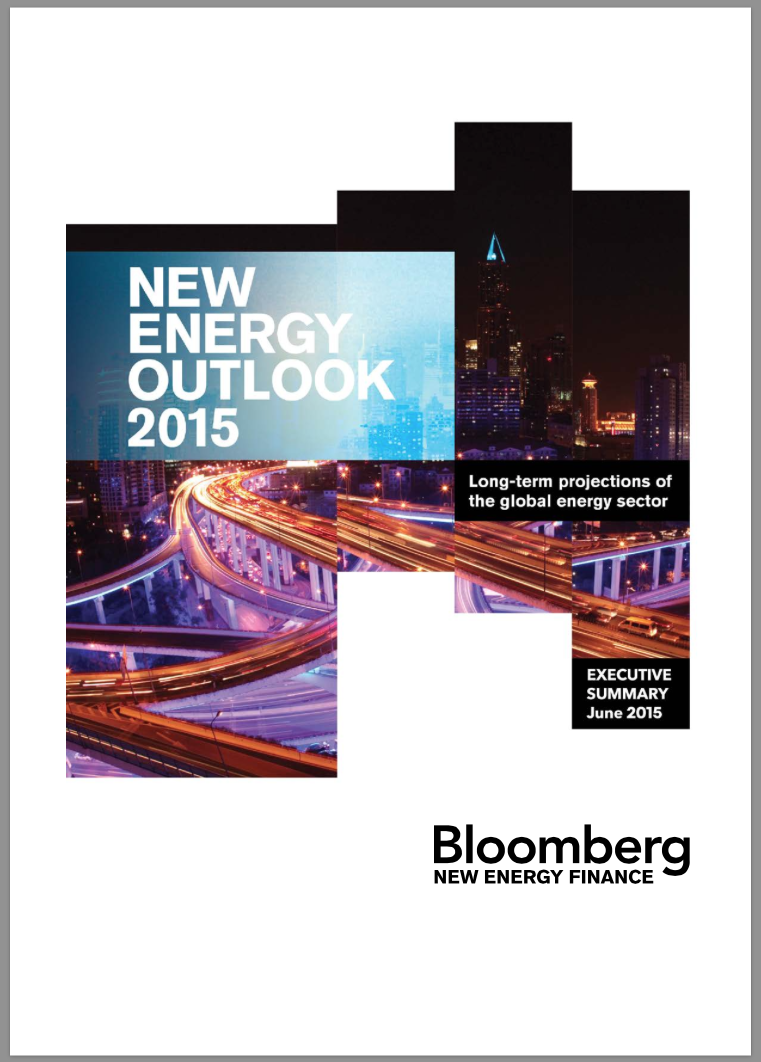Bloomberg verwacht biljoenen investering in zonnepanelen
29 juni 2015 – Het onderzoeksbureau Bloomberg New Energy Finance (BNEF) verwacht dat particulieren en bedrijven in de komende 25 jaar 2,2 biljoen dollar zullen investeren in zonnepanelen.

Uit een bericht van De Groene Courant
‘(BNEF verwacht) dat tot en met 2040 er in totaal zo’n 3,7 biljoen dollar wordt geïnvesteerd in zonne-energie op grote en kleine schaal. Kleinere zonnepaneelinstallaties worden steeds aantrekkelijker doordat het makkelijker wordt om energie lokaal ook op te slaan. BNEF verwacht dat ook steeds meer ontwikkelingslanden gaan investeren in kleine systemen. (…) Tegen 2040 hebben ontwikkelingslanden 1 biljoen dollar besteed aan kleinschalige pv-systemen.’
Uit een bericht van BNEF over het eigen onderzoek
(…) It identifies the following five major shifts that will take place between now and 2040:
- Solar, solar everywhere. The further decline in the cost of photovoltaic technology will drive a $3.7 trillion surge in investment in solar, both large-scale and small-scale.
- Power to the people. Some $2.2 trillion of this will go on rooftop and other local PV systems, handing consumers and businesses the ability to generate their own electricity, to store it using batteries and – in parts of the developing world – to access power for the first time.
- Demand undershoots. The march of energy-efficient technologies in areas such as lighting and air conditioning will help to limit growth in global power demand to 1.8% per year, down from 3% per year in 1990-2012. In OECD countries, power demand will be lower in 2040 than in 2014.
- Gas flares only briefly. Natural gas will not be the “transition fuel” to wean the world off coal. North American shale will change the gas market, but coal-to-gas switching will be mainly a US story. Many developing nations will opt for a twin-track of coal and renewables.
- Climate peril. Despite investment of $8 trillion in renewables, there will be enough legacy fossil-fuel plants and enough investment in new coal-fired capacity in developing countries to ensure global CO2 emissions rise all the way to 2029, and will still be 13% above 2014 levels in 2040.
(…)
The result is that, with global electricity generation rising by 56% between 2014 and 2040 as economies develop and populations grow, global power sector emissions will increase from 13.1 gigatonnes to a peak of 15.3Gt in 2029. Greater burning of coal by developing countries will more than offset the substitution of coal-firing by gas and renewables in developed economies. World emissions will then fall back, but only to 14.8Gt in 2040, still 13% above 2014 levels.
Seb Henbest, head of Europe, Middle East and Africa for Bloomberg New Energy Finance and lead author of NEO 2015, said: “The CO2 content of the atmosphere is on course to exceed 450 parts per million by 2035 even if emissions stay constant, so the trend we show of rising emissions to 2029 makes it very unlikely that the world will be able to limit temperature increases to less than two degrees Centigrade.
“The message for international negotiators preparing for the Paris climate change conference in December is that current policy settings – even combined with the vast strides renewables are making on competitiveness – will not be enough. Further policy action on emissions will be needed.”
Bronnen
De Groene Courant, 25 juni 2015: BNEF: 2,2 biljoen naar zonnepanelen op daken komende 25 jaar
Bloomberg New Energy, 23 juni 2015: Five seismic shifts to shake global electricity over next 25 years
Rapport BNEF, 23 juni 2015: New Energy Outlook 2015 (samenvatting, pdf, 7 pag.) (Volledige rapport tegen betaling)



